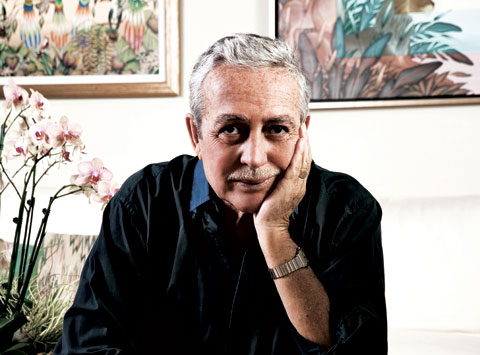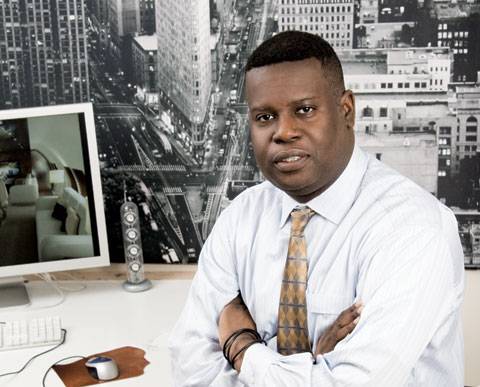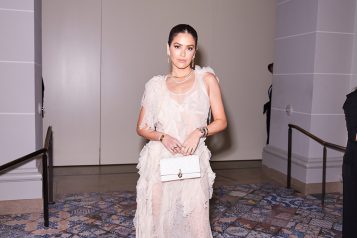
Novoa constructed a new dreamlike jungle where lions lie down with the zebras; panthers and pandas share shady trees with African monkeys and American raccoons.
In a few weeks, artist Gustavo Novoa is going to Berlin. Oh, he’s got his reasons, and he’ll be more than happy to show you the proof, which just so happens to be a wrinkled photocopy of an article from the International Herald Tribune that a good friend sent to him. It has him fired up, thoughts of raging all night with “artists of all stripes” and scandalous “all-girl punk orchestras,” all while singing karaoke. He has heard that Berlin is like Gotham in the 1980s, and that it has become the cool and creative capital of Europe. He’s heard there’s a comic exuberance thriving there, framing the provisional, the experimental, the cerebral-which in layman’s terms means that it’s wild. So really, he’s simply going for the hell of it. Did I mention he’s 67 years old?
Embodying the spirit of a 27-year-old rather than a soon-to-be septuagenarian, Gustavo Novoa-the man-defies simple age classifications. Novoa the painter toys with them in the flick of a brush. His work is defined by a rich palette, an inventive approach, and his accessible subjects. Combining fantasy, spirituality, and nostalgia with a distinctive modern painting style, Novoa’s canvases are filled with joyous, dreamlike simplicity. Even as styles have shifted, his work has remained individual and idiosyncratic, embracing storytelling, allegory, and memory. Always vivid in color and texture, Novoa’s highly collectible art reflects a distinct and personal mix of sources and ideas, resulting in both a prodigious oeuvre and an eclectic list of collectors, which includes Prince Charles, the Fords, Shareef Malnik, Hanae Mori, Mrs. Cornelius Vanderbilt Whitney, Oliver Stone, Sylvester Stallone, Beverly Sills, Barbara Bush, and Haute Living’s own Robert Farmer.
Born into a multi-generational family of lawyers in Santiago, Chile, Novoa attended the Academy of Fine Arts as well as one year of law school, only to learn that a structured profession was not his bag. Disinterested in climbing the corporate career ladder, Novoa took that ladder and put it on its side.
With a self-taught technique, Novoa made his debut as an artist in the early 1960s selling watercolors and works in crayon on the streets of Paris, principally Monmartre. As he recalls, “Some doors were opened thanks to kind friends. Some were already open, but it took courage to go through them. And the other doors were pried open with a lot of maneuvering and some SW 40 oil.”
His first one-man show was sponsored by the Chilean Ambassador at the Maison de L’Amérique Latine in 1961. The late Queen Victoria Eugenia of Spain sponsored his second show in Lausanne, Switzerland, in 1962. Novoa showed his artwork in galleries in the Faubourg Saint-Honore and the Salon de la Jeune Peinture, but by 1965, he made the transition from a Parisian to a New Yorker. He admits to having been lured like many others by the American dream on the one hand, and movies such as West Side Story, Breakfast at Tiffany’s, and The Wizard of Oz on the other.
A successful partnership with Guy Burgos, and later, Lady Sarah Churchill, led to the opening of the Burgos Gallery on Manhattan’s East Side in 1965. By then, his style had evolved to textured oils that New York Times’ critic Stuart Preston wrote, “What Novoa seeks to discover in his often fanciful landscapes and still lifes is their identity, that special something that makes them unique.” By the late ’60s, however, Novoa’s subjects had morphed into the gentle jungle inhabitants that were to one day be his trademark.
Novoa constructed a new dreamlike jungle where lions lie down with the zebras; panthers and pandas share shady trees with African monkeys and American raccoons. The gently radiant colors of Novoa’s abundant foliage wields a mystical power, strong enough to bring together predator and prey, the meek and the strong; opposite forces transcend the ruthless laws of nature to bring harmony to the jungle. So which animal does the artist consider himself? “A black panther trapped in the body of a well-traveled painter,” he laughs. “It could be worse.”
In the early 1970s, Novoa became represented exclusively by the Wally Findlay Galleries, and his one-man shows in New York, Paris, Palm Beach, and Beverly Hills established him as a champion of ecology and wildlife preservation. His animals were primitive and painted with lush and colorful backgrounds. In 1977, the publication of his book Jungle Fables, for which he wrote the text and executed the paintings, was a collection of rhymes on “vice and virtue” that gave a new dimension to his animals, making them more anthropomorphic and philosophical. Ringling Bros. and Barnum & Bailey, even commissioned him to do the poster and program for the circus that year.
By 1981, Novoa’s paintings had taken on a new form once again. His show, “The Grand Tour,” sent his animals prowling the major cities of the world, from the Spanish Steps in Rome to the Left Bank in Paris, through the Great Pyramids and back to Park Avenue in New York. It was perhaps the most surrealistic of Novoa’s shows. “I started as a primitive painter,” he explains, “and became a surrealist. When people ask the inevitable question, ‘what kind of paintings do you do?’ I always say that if Rousseau and Magritte had had a child, it would probably be me.”
In 1986, Novoa visited Arizona and New Mexico and soon after, his jungle characters were set aside. Instead, Novoa returned to his palette knife paintings of the ’60s with a new style and new subject matter showing the American influence in his new works. He depicted the Arizona desert and the Indian pueblos with haunting surreal qualities under the heavy impasto, which he dubbed his “adobe” period. Because Novoa’s horizon expanded beyond the jungles of his mind, his newest collection featured a group of paintings of Deco architecture. Miami’s Preservation League commissioned him for the cover of the program for the Art Deco weekend and his painting, Dreamline-Streamline, became the theme of the event. His one-man show at the Steiner Gallery in Bal Harbour landed Novoa on the front page of the Miami Herald in 1988.
On April 3, 1988, Prince Charles of England set a new record for Novoa’s sales by auctioning one of his paintings at a benefit in Palm Beach. In April of 1991, Novoa was received at the White House by Mrs. George Bush. Miami’s Art Deco District had chosen Novoa’s painting, The Carlyle Hotel, to be presented to the First Lady. The piece now hangs in the President’s Library. The prestigious 1-2-3 Gallery of El Salvador introduced Novoa at their Latin American Biennial exhibition in June 1992, while the Instituto Cultural de Santiago presented an impressive one-man show in August of that year, the first exhibition in his homeland. The Chilean press dubbed him “Painter of a Lost Paradise.” Sponsored by Avensa Airlines of Venezuela, Novoa opened his first one-man show in Caracas with typical success at the Galeria Oscar Ascanio in June 1993. And in July 1997, the Wally Findlay Galleries in New York celebrated the publication of Novoa’s retrospective hardcover book, Paradise Found, with a one-man show and book signing.
Novoa’s success continues to snowball, as does his spirit. Ever inquisitive and searching, he is in constant evolution. “Artists like Gaugin and Dali, they influence my work, but I always reinterpret their ideas, creating new concepts and images, alongside fermenting ideas from sci-fi movies, dreams, and my life. I tell my mind’s computer to program it, and inevitably I come with results in due time.” Those results have helped produce the 2006 hardcover book, Paradise Revisited, and Novoa’s newest works will be unveiled with a one-man show at the Wally Findlay Gallery in New York in 2009. Until then, you can view his artwork online at GustavoNovoa.com, or there’s always the option of meeting up with him in Berlin…if you think you can keep up with the prowling black panther.




















